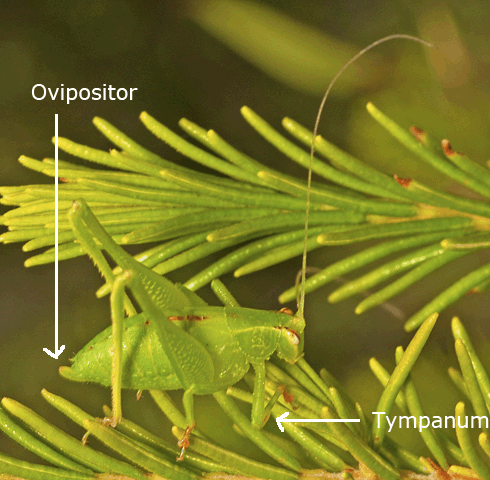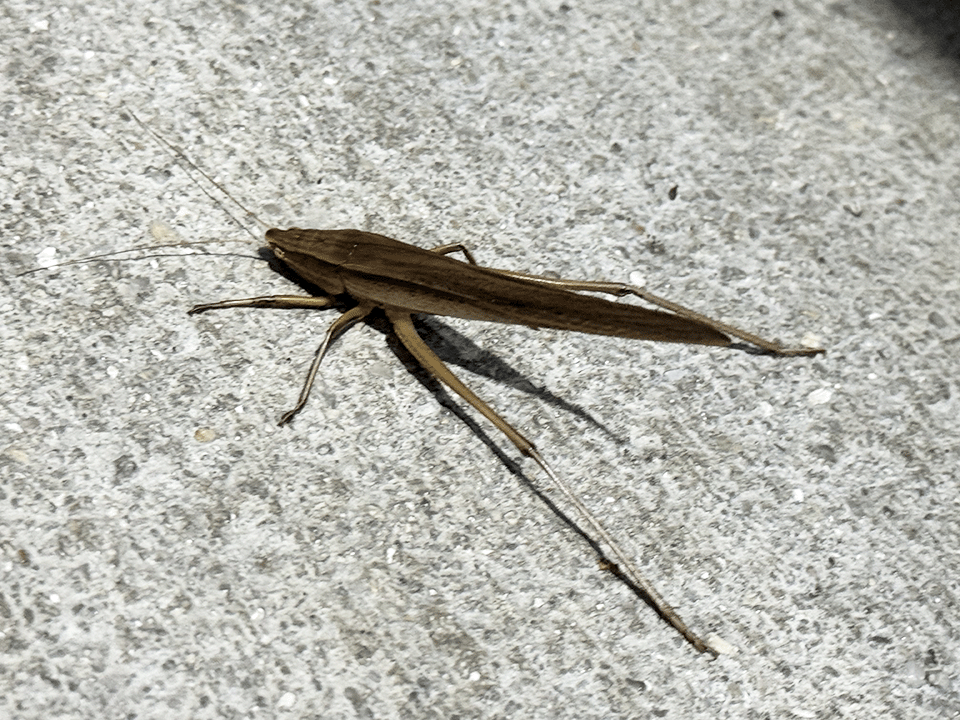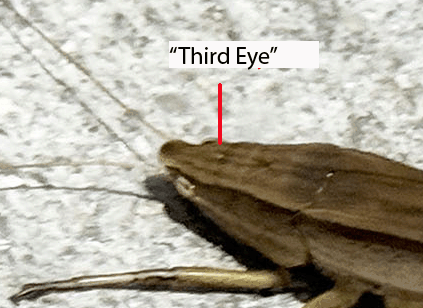Order Orthoptera (Grasshoppers, Crickets, and Katydids) in the Christopher B. Smith Preserve
Order Orthoptera Characteristics: About 250 species of orthopterans live in Florida. They include grasshoppers, crickets, mole crickets, and katydids.
Some orthopterans are wingless, while others have short wings, or wings extended the full length of the body. Those orthopterans with wings have two pair; the front wings are fairly straight. In fact, "Orthoptera" means "straight wings." When at rest, the leathery forewings usually cover and protect the membranous hindwings.
Members of the order have a cylindrical body; large, compound eyes; thread-like antennae; slightly to greatly enlarged hind femora, which allow them to leap great distances; tarsi with fewer than five segments, chewing mouthparts, and gradual metamorphosis (egg, nymph, adult.)
Males of most species produce sounds ("stridulations") to attract females. A cricket, katydid, or mole cricket produces sound by rubbing the tiny pegs on one of its forewings over a file-like apparatus on the other forewing. A singing grasshopper produces sound by rubbing the base of one of its hind legs across the leading edge of one of its front wings.
Interactions in the Smith Preserve: Most orthopterans eat plants. Orthopteran species are major food sources for song birds and game birds, and they are also consumed by lizards, snakes, frogs, spiders, and rodents.
Family |
Species Name |
Common Name |
Acrididae |
Dichromorpha viridis |
|
Acrididae |
Spharagemon marmorata |
|
Acrididae |
Schistocera americana |
|
Acrididae |
Unknown |
|
Gryllidae |
Cyrtoxipha columbiana |
|
Gryllidae |
Hapithus sp. |
|
Romaleidae |
Romalea guttata |
|
Tettigoniidae |
Montezumina modesta |
|
Tettigoniidae |
Unknown |
|
Tettigoniidae |
Unknown |
|
Tettigoniidae |
Neoconocephalus triops |
Family Acrididae Dichtromorpha viridis ... Short-Winged Green Grasshopper
|
Family Acrididae Spharagemon marmorata ... Marbled Grasshopper
|
Family Acrididae Schistocera americana ... American Bird Grasshopper
|
Family Acrididae Unknown Species ... Short-Horned Grasshopper
|
Family Gryllidae Cyrtoxipha columbiana ... Columbian Trig
|
Family Gryllidae Hapithus sp. ... Flightless Bush Cricket
|
Family Romaleidae Romalea guttata ... Eastern Lubber Grasshopper
|
Family Tettigoniidae Montezumina modesta ... Modest Katydid / Bush Katydid
|
Family Tettigoniidae Unknown Species ... Meadow Katydid
|
Family Tettigoniidae Unknown Species ... Long-Horned Grasshopper
|
Family Tettigoniidae Neoconocephalus triops ... Broad-Tipped Conehead/ Three-Eyed Conehead Katydid
|

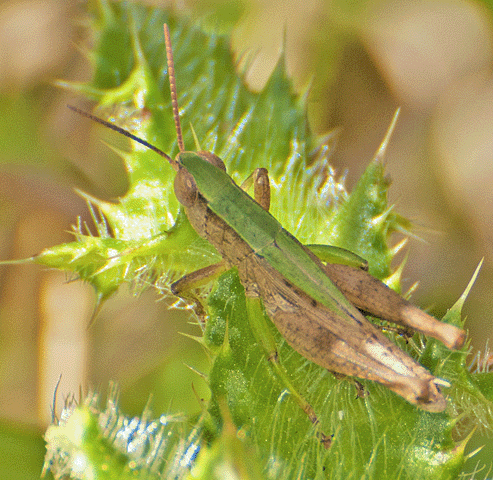 There are about 70 species of grasshoppers in Florida. They, along with pygmy mole crickets belong to Suborder Caelifera. All members of this suborder have the following characteristics in common: 1) The antennae are short, usually less than half the length of the body. 2) If tympana (sound receiving structures) are present, they are is located on the abdomen. 3) The tarsi have three or fewer segments. 4) The hind femora are usually enlarged for jumping. 5) Females lack an obvious visible ovipositor.
There are about 70 species of grasshoppers in Florida. They, along with pygmy mole crickets belong to Suborder Caelifera. All members of this suborder have the following characteristics in common: 1) The antennae are short, usually less than half the length of the body. 2) If tympana (sound receiving structures) are present, they are is located on the abdomen. 3) The tarsi have three or fewer segments. 4) The hind femora are usually enlarged for jumping. 5) Females lack an obvious visible ovipositor.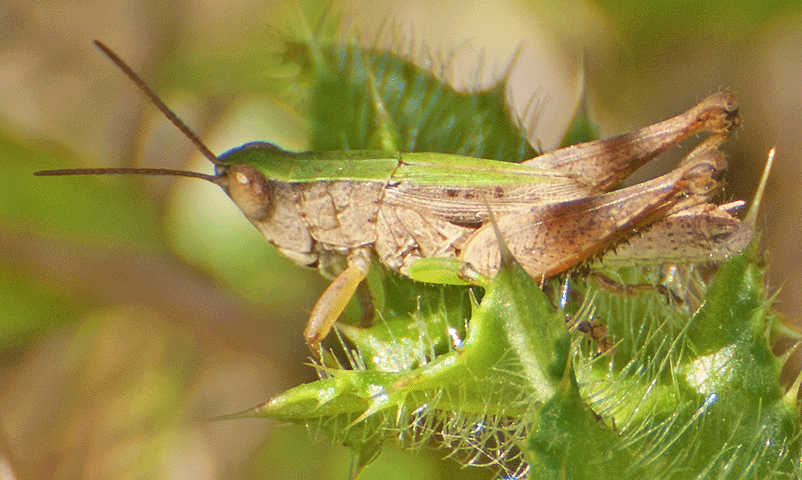
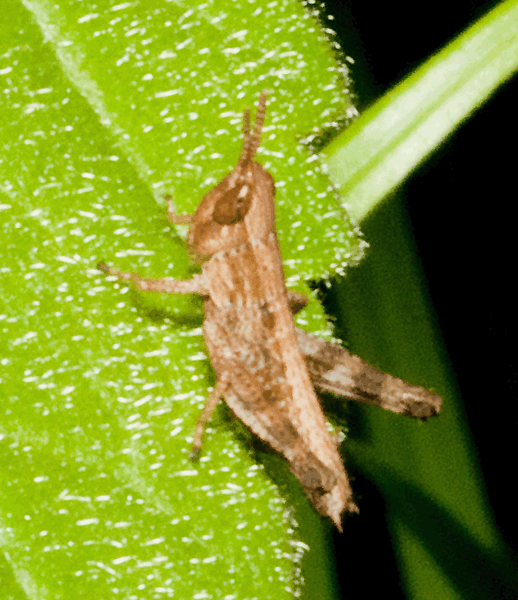
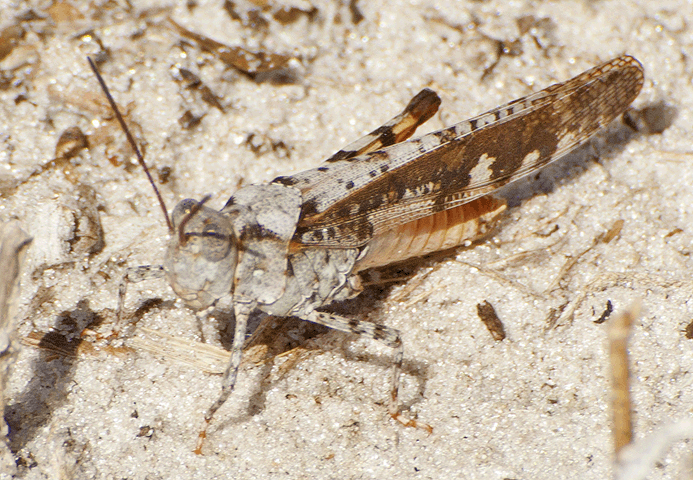
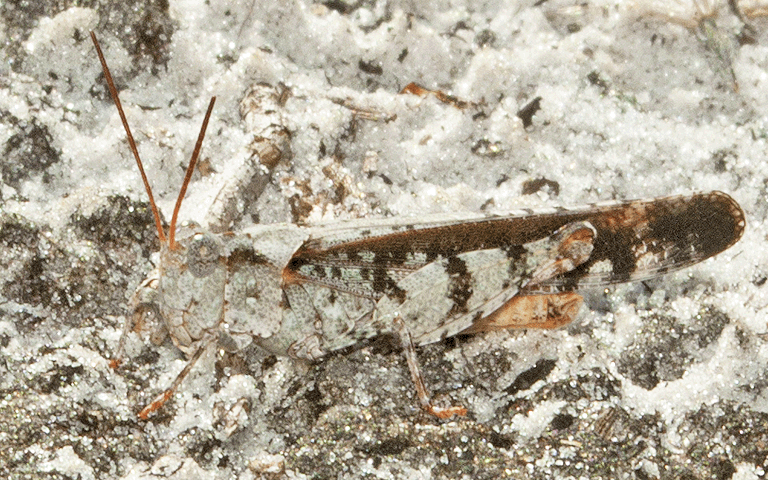
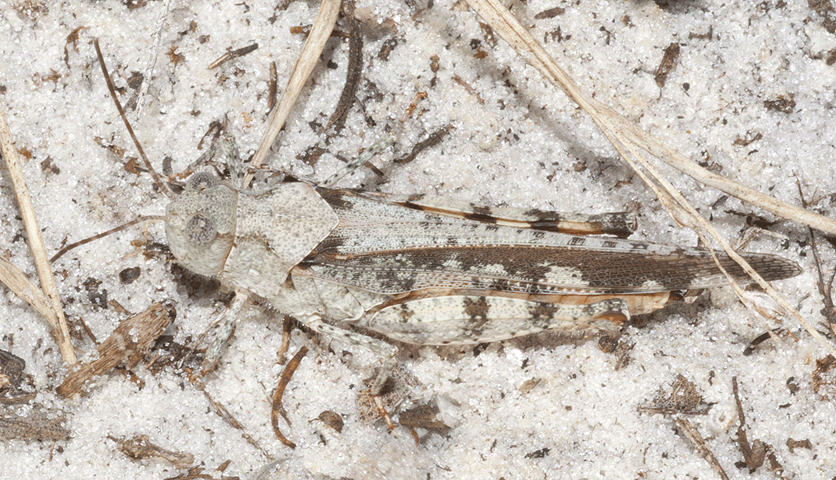
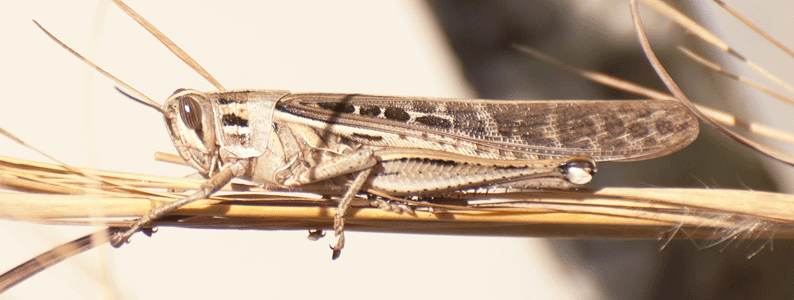
 As shown, adults of this species are generally yellow-brown with pale wings with large brown spots.
As shown, adults of this species are generally yellow-brown with pale wings with large brown spots.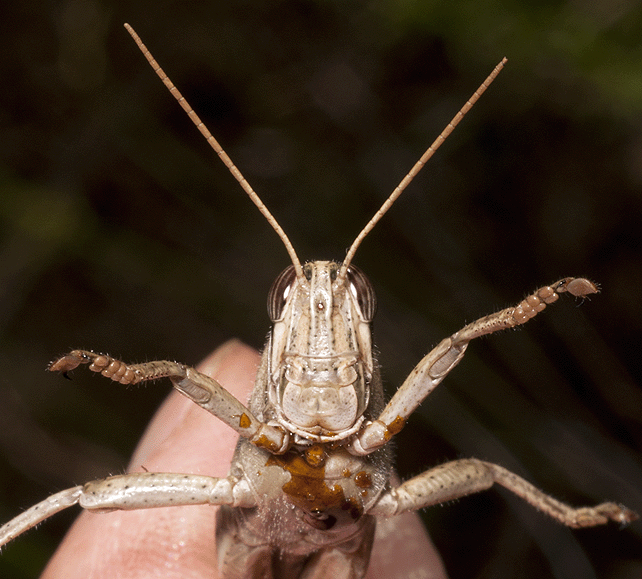 This species, like some other grasshoppers, produces a regurgitant which causes the plant to respond by producing a substance that attracts predators of the grasshopper. The regurgitant might also be used by the grasshopper as a defense. When this particular grasshopper was captured (in order to be photographed), it expelled a large amount of regurgitant. That is the brown stain on its abdomen.
This species, like some other grasshoppers, produces a regurgitant which causes the plant to respond by producing a substance that attracts predators of the grasshopper. The regurgitant might also be used by the grasshopper as a defense. When this particular grasshopper was captured (in order to be photographed), it expelled a large amount of regurgitant. That is the brown stain on its abdomen. 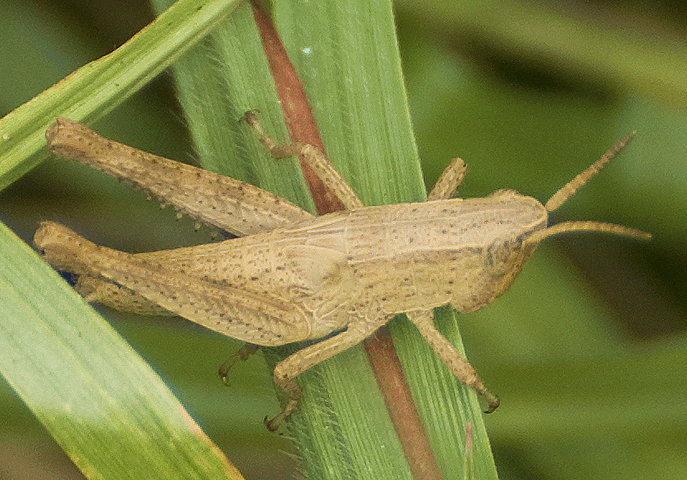
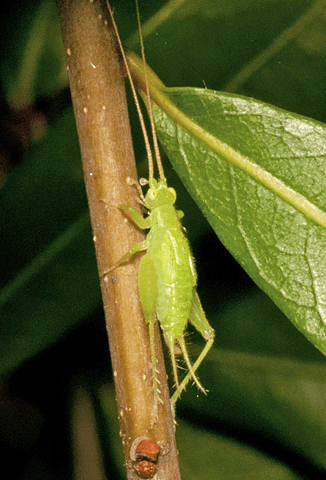
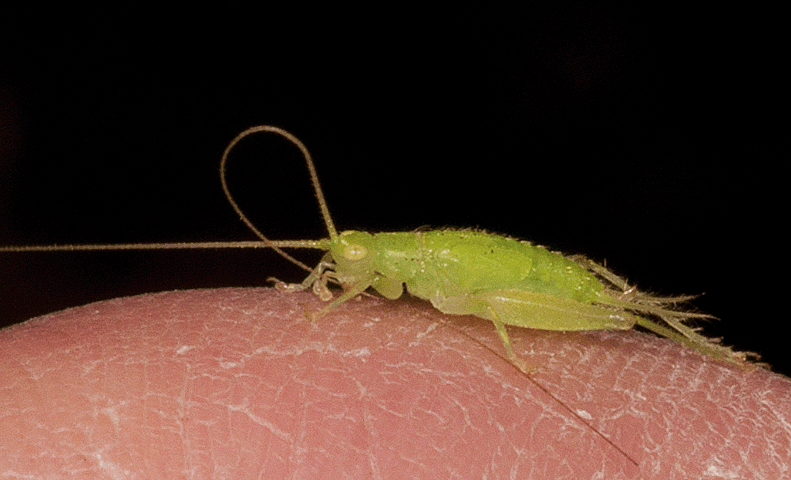
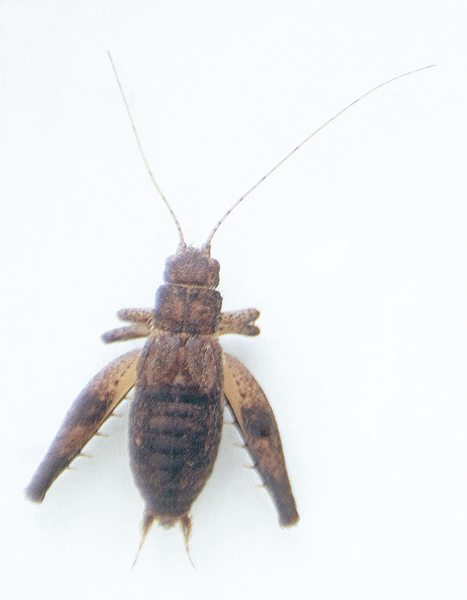

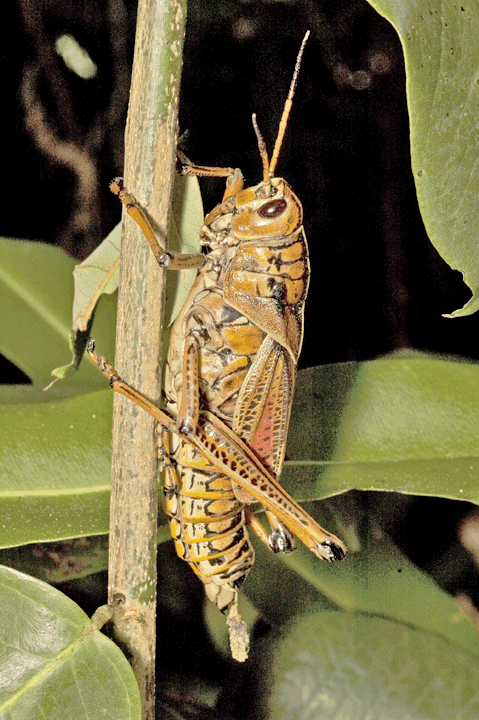 As an adult, this grasshopper is easily identifiable because it is so large and brightly colored. Adults have bright red underwings.
As an adult, this grasshopper is easily identifiable because it is so large and brightly colored. Adults have bright red underwings. 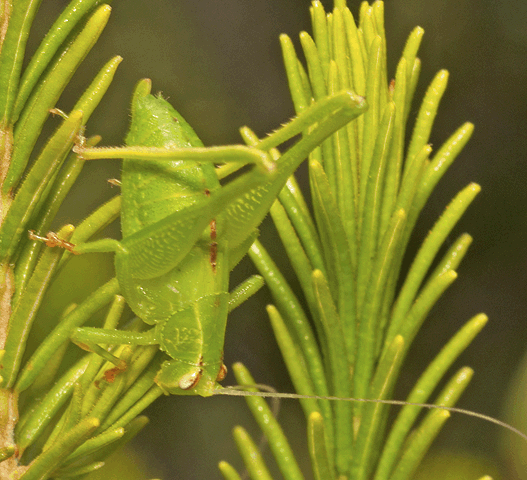 A katydid holds its wings roof-like over its body. Other characteristics include: 1) tarsi with four segments, 2) tympana (ears) located on the front tibiae, 3) very long and fine antennae, and 4) slender jumping legs.
A katydid holds its wings roof-like over its body. Other characteristics include: 1) tarsi with four segments, 2) tympana (ears) located on the front tibiae, 3) very long and fine antennae, and 4) slender jumping legs. 